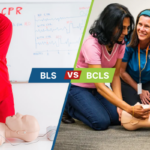
- Last Updated On: July 16, 2024
Online CPR Vs in-person CPR: Which one is better?
CPR stands for cardiopulmonary resuscitation. It is a life-saving skill that can help someone who is not breathing or has no heartbeat. CPR can be learned online or in person, but which one is better? In this blog post, we will compare online and in-person CPR courses and help you decide which one is best for your needs.
If online education is your preference then American CPR Care Association is the most trustworthy source of knowledge and learning in the case of CPR and other life support certifications. To get your CPR online certification, all you have to do is:
– Select your course
– Pass the test
– Print your certification
In the next section, you’ll read about the benefits of pursuing the CPR online certification from us. We’ll also analyze both sides of the coin – online vs. offline training – in the subsequent sections.
Benefits of doing online CPR certification from the American CPR Care Association
One of the benefits of doing online CPR certification from the American CPR Care Association is that you can learn at your own pace and convenience. You don’t have to travel to a classroom or follow a fixed schedule.
Along with this, you can access the course materials anytime and anywhere. You just need to have an uninterrupted internet connection. You can also review the lessons as many times as you need until you feel confident.
Another benefit of doing online CPR certification from the American CPR Care Association is that you can save money and time. Online CPR courses are usually cheaper than in-person cpr and first aid courses. They don’t require instructors, equipment, or facilities. You also don’t have to pay for transportation, parking, or childcare costs.
Lastly, online CPR courses can be completed in a few hours. This will save a lot of time. You won’t be required to take a day off from work or require someone to watch your kids. On the other hand, in-person courses can take a whole day or more.
Pros and cons of online CPR courses
Online CPR classes have many advantages, but they also have some drawbacks. Here are some of the pros and cons of online CPR courses:
Pros:
– Flexible and convenient
– Affordable and fast
– Self-paced and interactive
– Accredited and nationally recognized
Cons:
– No hands-on practice
– No feedback from instructors
– No interaction with other students
– No certification card on the spot
Differences and similarities between online and in-person CPR training
Online and in-person CPR training have some differences and similarities. Here are some of them:
Differences:
- Online CPR training uses videos, animations, quizzes, and simulations to teach the skills and knowledge of CPR.
- In-person CPR training uses manikins, AEDs, and other equipment to teach the skills and knowledge of CPR.
- Online CPR training requires a skills test with a local instructor or an authorized provider to get the certification card.
- In-person CPR training gives the certification card right after completing the course.
Similarities:
- Online and in-person CPR training follow the same guidelines and standards from the Occupational Safety and Health Administration (OSHA).
- Online and in-person CPR training covers the same topics and skills, such as adult, child, and infant CPR, choking relief, AED use, first aid, and bloodborne pathogens.
- Online and in-person CPR training have the same validity period of two years.
How to choose the best CPR course for your needs?
The best CPR course for your needs depends on several factors, such as your learning style, your budget, your availability, your purpose, and your preference. The good news is that the American CPR Care Association answers all your doubts. Here are some questions to ask yourself before choosing a CPR course:
- Do you prefer to learn online or in person?
- How much money are you willing to spend on a CPR course?
- How much time do you have to complete a CPR course?
- Why do you need a CPR certification? Is it for work, school, personal interest, or other reasons?
- What kind of CPR certification do you need? Is it basic or advanced? Is it for healthcare providers or lay rescuers?
Conclusion
Online and in-person CPR courses have their pros and cons. They also have some differences and similarities. The best way to choose a CPR course is to consider your needs and preferences. Whether you choose online or in-person CPR training, the most important thing is to learn how to save a life.
Also read: How long does cpr certification lasts?






